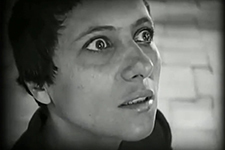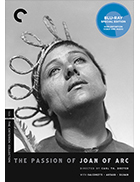The Passion of Joan of Arc (La passion de Jeanne d’Arc)
|  Although history has not preserved his name (at least to my knowledge), there was a man who worked at the Dikemark Sykehus (Dikemark Mental Asylum) in Asker, a suburb of Oslo, Norway, who made a uniquely important and completely unexpected cinematic discovery. While cleaning out the asylum’s cellar in 1981, he came across a trunk containing several film canisters: nine shorts and one feature. He had the wherewithal to phone the Norwegian Film Institute (NFI) and had the canisters shipped there, although it was another three years before anyone actually opened them to assess their contents, mainly because the institute had been flooded with prints following an advisory sent out in 1980 about the dangers of storing nitrate prints. The job of assessing the canisters’ contents fell to senior NFI archivist Arne Pedersen, who was the first to identity that the 35mm nitrate feature was a copy of the original version of Carl Theodor Dreyer’s silent-era masterpiece The Passion of Joan of Arc (La passion de Jeanne d’Arc) with Danish intertitles. A copy was sent to the Danish Film Museum, and two months later it was confirmed that the so-called “Oslo print” was, indeed, a copy of the original version of the film. An official press release went out on November 16, 1984, confirming to the world that Dreyer’s film, whose original negative had been destroyed in a fire in the late 1920s, had existed only in various butchered, edited, censored, and variously reconstructed versions, still existed. It is one of the great stories of a film lost and then found, even though the “Oslo print” did not differ dramatically from several other copies of the film held in various archives around the world, including the Museum of Modern Art in New York and the British Film Institute. However, the differences are there, and the rediscovered print was also substantially higher in visual quality, bringing out new levels of nuance and detail and contrast that had long been lost in the haze of multi-generation dupe prints. It would be a great story even if The Passion of Joan of Arc had been only a mildly interesting film, rather than the masterpiece that it is—a pinnacle of silent film art, expressive acting, and naturalistic intensity. Dreyer had been directing films for almost a decade in his native Denmark, and he had a few minor successes under his belt, including the dramas Leaves From Satan’s Book (Blade af Satans bog, 1920) and Master of the House (Du skal ære din hustru1925), but nothing indicated the wells of dramatic power he would unleash in The Passion of Joan of Arc. The film was immediately controversial due to the fact that Dreyer was a cultural outsider directing a film about one of France’s greatest and most beloved national heroes, a martyr and confirmed saint who was also the subject of a competing film, Marco de Gastyne’s Saint Joan the Maid (La merveilleuse vie de Jeanne d’Arc, 1929), a more conventional, epic take on the story. Dreyer had been invited to make the film in France by the Société Générale des Films, a short-lived prestige production company that had earlier funded Abel Gance’s ambitious (and extremely expensive) Napoleon (1927), and he spent nearly a year researching Joan’s life and based the majority of the script (which was co-written by Joseph Delteil) on the actual trial transcripts, which had been published in a new edition in 1921 by medieval historian Pierre Champion, who was arguably the leading authority on Joan of Arc. As the film’s title suggests, Dreyer chose to focus the entirety of the film on Joan’s trial in the King of England’s military headquarters in Rouen, which gives the film a sense of intensified focus that Dreyer and cinematographer Rudolph Maté emphasize even more with their emphatic, almost unrelenting reliance on close-ups. Although massive sets were built at great expense, very little of them shows up on the screen because Dreyer is obsessed with the faces of Joan and her relentless persecutors. To play Joan, Dreyer chose Renée Jeanne Falconetti (aka Maria Falconetti), an accomplished stage actress who had appeared in only one feature film, the largely unseen and otherwise forgotten La comtesse de Somerive (1917). Given her lack of screen experience, Falconetti’s casting was a gamble, but it turned out to be a brilliant one; in collaborating with Dreyer, she delivered what has become recognized as one of the legendary screen performances—a raw, unflinching, utterly compelling portrait of a woman in intense spiritual and psychological turmoil as she is questioned, cajoled, mocked, and berated by her accusers. Dreyer holds her unadorned face in extreme close-up throughout most of the film, allowing us to absorb the intensity of her experience; although Falconetti looks too old for the part—she was 35 playing a 19-year-old—she conveys the character’s sense of almost childlike bewilderment as she struggles to reconcile the veracity of her own spiritual experience with the bullying charges of blasphemy being leveled against her. Like many of Dreyer’s later films, most notably Day of Wrath (1943), this is a film about the individual being crushed by a monotonous system of power and authority that fears unsanctioned experience. At no point does the film suggest that any aspect of Joan’s experience is not genuine; her closeness to God is literally the only thing that can explain her insistence and her refusal to back down, even in the face of a gruesome death. Which is not to say that she does not feel fear and is not tormented by the inquisition. At times she is wide-eyed and terrified, never so much as in the scene when she is threatened with physical torture; at other times she is defiant and even sardonic, replying to her accusers’ questions with questions of her own; but ultimately she is decimated, her head shaved, her body broken with exhaustion (but her spirit remarkably unsullied) as she is marched out to the stake where she will be burned alive in the film’s ecstatic climax. At this point Dreyer breaks loose from the rigid confines of his close-up aesthetic and allows the camera to run wild in the streets as Joan’s public execution turns into utter chaos. At other time in the film when Dreyer moves away from Joan, he often turns his attention toward action that comments critically on the proceedings, such as his intercutting the shaving of Joan’s head, the point at which she has been reduced to her lowest, with a carnival outside populated by contortionists and sword swallowers. Just as we do now, so did the denizens of 15th-century France turn their attention from genuine travesty to mindless entertainment. The Passion of Joan Arc remains a monumental work of cinematic art and testament to the power of the human face. The fact the Dreyer’s original version went unseen for nearly 50 years is a tragedy, although its rediscovery and wide circulation in the years since has guaranteed its place in the canon of great films, instead of being relegated to the realm of “What could have been?” populated by the likes of Orson Welles’s butchered The Magnificent Ambersons (1942) and Jerry Lewis’s notorious still-unreleased Holocaust drama The Day the Clown Cried (1972). It is a wholly unique film, one that conveys with unflinching power the seemingly contradictory meanings of that all-important word passion: both Joan’s intense feeling of all-consuming love and the brutal suffering inflicted upon her. The Passion of Joan of Arc is an emotionally exhausting experience, which is exactly as it should be.
Copyright © 2018 James Kendrick Thoughts? E-mail James Kendrick All images copyright © The Criterion Collection | |||||||||||||||||||||||||||||||
Overall Rating: 


 (4)
(4)


